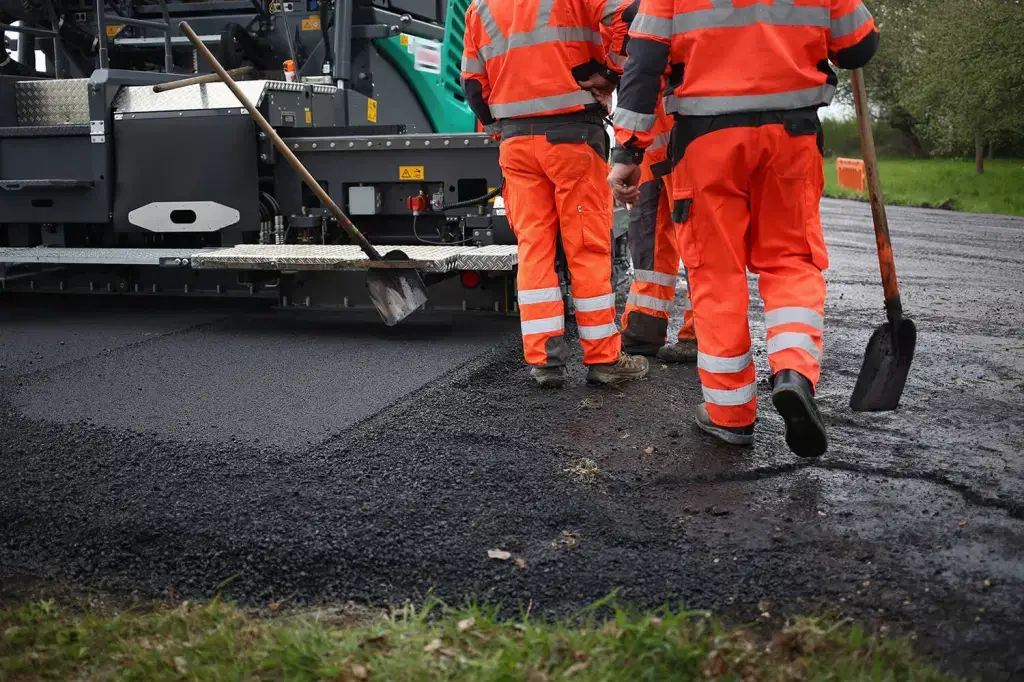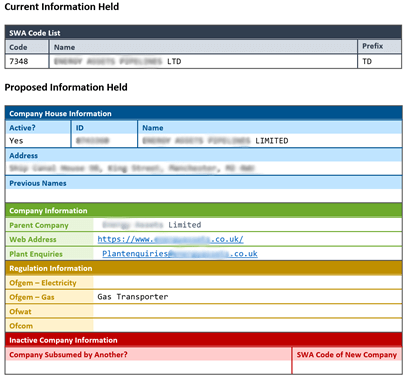If you don’t have a unique Street Works Act (SWA) code, then you cannot carry out works in the street – but the list of SWA codes itself must be usable, dependable, and authoritative.

SWA Codes (also known as Department for Transport Data Capture Codes), are as fundamental to the management and coordination of streetworks as Unique Street Reference Numbers (USRN). Allocated as and when they’re needed to authorities and statutory undertakers, the SWA code list defines which organisations are actually capable or have the authority to carry out works in the street. However, that list had not been reviewed for some time. Therefore, we undertook a complete review and rebuild of the SWA code list, using our experience in data management to overcome some inherent challenges.
The background
Each organisation is given a four-digit code, with an alphanumeric prefix, which identifies them clearly at all stages of the street works process. Technically, this is much easier and more efficient than using department or organisation names, but the issue of a code also reassures other stakeholders that the teams in questions are appropriately licensed and authorised to be undertaking street works. Confidence and authority are the foundations on which successful, efficient works are organised via noticing or permitting.
Any organisation that has statutory powers to work in the street can apply for a code. Most of the time, their authority comes from the Highway Act, the New Road and Street Works Act (NRSWA) or Traffic Management Act (TMA), although others are possible. Organisations that would need a code fall into three broad areas:
- Local authorities
- Statutory undertakers
- Other government or statutory bodies
Under the Electronic Transfer of Noticing (EToN) process, organisations with a code could send notices and permits of intent for works in the street. EToN has been superseded by the Department for Transport’s Street Manager and SWA codes are now needed for access instead.
Unless they are contracted to do so by an organisation that does have one, an organisation without an SWA code can’t access the National Street Gazetteer (NSG) to plan or raise an intent for works.
How to get a code
GeoPlace has been managing the allocation of new SWA codes since 2012. But there’s a lot more to it than simply handing out a code when an application comes in. There are serious responsibilities involved in authorising the right organisations to work in the street.
Against any new request for an SWA code (the service can be found here), GeoPlace does a comprehensive series of checks to make sure core requirements have been met:
- Background checks, such as verification against Companies House
- Confirming the applicant is a Statutory Undertaker as opposed to a contractor
- Confirming the applicant is subject to an official regulator (Ofgem, Ofwat and Ofcom).
When it’s clear that an application meets all of those requirements, a formal sign off can be given to the issue of a new code by HAUC(UK).
So why did we want to review the SWA code list?
In a recent High Court case (Norfolk County Council vs. Calor Gas), it was determined that an authority may refuse to adopt a road if the infrastructure is owned by an organisation that doesn’t have statutory powers (a status that’s confirmed, or not, by having an SWA code).
This is just one example of the problems that might arise if the SWA code list isn’t up to date and managed effectively. However, when we took over the list’s day-to-day administration, there was no protocol in place for managing organisations that already had codes, nor was there an agreed process to manage information updates on or about those organisations.
Changes in the streetworks management industry are frequent, with organisations changing names, being subsumed into another, or even ceasing to exist. In addition, to mitigate any licensing problems, access to Street Manager is based on the SWA code list – so we wanted to improve confidence levels all round in the codes being issued.
We focused on three issues: currency, absence of information, and incomplete information.
Currency of the SWA Code List
Some information held against the SWA codes themselves was 30 years old and had never been reviewed. The issues included:
- Organisations without the necessary rights should have been removed
- Organisations had stopped trading
- Organisations had been acquired by other companies, subsumed, or evolved
- Organisation names had changed over time and not been updated
As well as bringing the SWA code list up to date, we introduced fixed protocols to ensure it will remain current.

Absence of history
Some records on the SWA code list had no indications of its history such as an organisation’s previous names, or which codes it might have subsumed. In terms of historic liabilities, this could have a significant impact for many stakeholders.
Absence of information
The information held with SWA Codes was limited. We could not determine if an organisation was active, some contact information existed but we couldn’t verify it, or the information that did exist related to an organisation’s relationship with GeoPlace rather than the street works industry.
Also, when an organisation applies for an SWA code, they are checked against the regulators to make sure they are correctly licensed to undertake street works. However, after being checked, many organisations either go on to gain extra powers under a different regulator, or indeed may lose their powers.
With the acceleration of competition, these changes to licenses, as well as the number of new small to medium size companies seeking code powers, has meant that the SWA list becomes extremely important in keeping track of which licenses organisations actually hold. Without this detail, works might be done by organisations that aren’t licenced (trained, insured, or able) to do those works adequately.
What we did
We managed the project in four stages:
- Review the allocation of 4-digit codes and prefixes
- Review all of the organisations on file, and the information being held about them
- Review the pertinent information held or needed for street works
- Deliver the report and recommendations to the industry
Reviewing the allocation of codes
SWA codes and their prefixes are integral to the coordination of street works. They’re hard coded as a prerequisite in the work streams of the Street Manager system. However, with a larger number of Statutory Undertakers applying for codes now, the code structure was no longer fit for purpose. We concluded that:
- The 4-digit code itself is still appropriate and there are enough codes for growth
- The SWA_ORG_PREFIX codes need an extension, so a new alpha-numeric convention will apply to any new SWA code being created. All new SWA_ORG_PREFIX allocations will now have a single character prefix and then a numeric value between 1 – 9.
This ensures the generation of codes is future proofed with no risk of duplication.
Reviewing the organisations on file
The current SWA code list had organisations that broadly split into the following types:
- Local highway authorities
- Statutory Undertakers
- Scottish organisations
- Fire & Rescue services
- Software providers
- Government bodies
We were confident the data collected for local highway authorities was up to date, as it’s needed for submitting data to the NSG. However, we decided the other organisation types should undergo a detailed review – 436 organisations in all.
The information we needed
We needed to understand what data had already been collected and where from. From our work with HAUC(UK), and Elaine Coope’s previous great work (first at Derbyshire County Council, now at Highways England) we could then work out what else would be useful. Data fell into three categories: company details, extra information, and regulatory information.
Company details
What we needed: Current company name, previous company name
Why: An organisation’s name is essential for search purposes, as are its previous names – enabling users to be confident about an organisation in question.
Where and how the information was collected: Companies House is the most up to date and accurate source of information for core company details. Every organisation must be registered there with up to date information. Crucially, it is readily available for public use and holds a lot of relevant information. We made the decision to fully align our Customer Relationship Management (CRM) information with the data at Companies House including the Companies House ID, the organisation’s current name and any previous names.
Additional company information
Required information: Linked/Parent Company details, website and plant enquiry information
Why the information was needed: The SWA code list tries to provide as much information as possible that’s relevant to street works. Keeping this information centrally located would save time and money for everyone involved.
Where and how the information was collected: No one place holds the data, so research was carried out once the organisations had been identified through Companies House.
Regulatory Information
Required information: Who regulates the organisation, what licence do they have?
Why the information was needed: Being regulated underpins the need for an SWA code. By identifying licenced organisations, and understanding what they can do, stakeholders have the confidence to move ahead – knowing street works are being done under correct licences and regulation.
Where and how the information was collected: Each regulator has its own website with a list of organisations that have a relevant licence. Each organisation on the original SWA code list was cross checked against the licence list.
Inactive organisation information
Required information: Where one organisation is subsumed by another, who is the new organisation and which SWA code is taking on the liability?
Why the information was needed: The organisation that owns the apparatus is likely to be the organisation that has responsibility and liability for the streetworks. But if an organisation is subsumed, then that liability and responsibility passes on – and the highway authorities need to know this in advance.
Where and how the information was collected: Much of the information was gathered through research and review of the organisations’ commercial histories.
Verifying the data
Every good database needs to have its content verified, regularly. Within our review, we found that some organisations had more than one entry at Companies House, particularly where an organisation had been subsumed. We also wanted to be confident that the review we undertook was right and comprehensive, so a communication was sent out to establish this.
Example of data held before and after the review

Ensuring the information remains current
Companies House broadcasts alerts when data is updated. We have set up an alert to follow every organisation we have reviewed, thereby ensuring our information’s integrity. In addition, we will be talking to the regulators – getting a feed of information that notifies us when organisations join and leave the published list – and we hope this review in itself will encourage organisations to contact us when changes happen.
Delivering the review
Increasing visibility of information
We wanted to increase the visibility of this information to the industry. Previously the focus had been on publishing a very basic dataset, with a downloadable file for suppliers to use.
Working with HAUC(UK), we decided to deliver the data in additional formats. An excel report, filterable makes it much more user-friendly, while still protecting the data itself.

A new landing page
An improved landing page was created here, to explain why the SWA codes exist and provide access to the files and report.
Informing the industry
Initial discussion and sign off was sought from both the DfT and HAUC(UK) that both the redesigned reports and new homepage met the high-level requirements for SWA codes and the industry. The industry and specifically organisations that were being reviewed were updated throughout the process.
Outcomes
In total, we reviewed and recorded over 6,500 pieces of information, splitting the organisations (including highway authorities) into three categories:
| Number of active organisations | 446 |
| Number of inactive organisations | 194 |
| Organisations registered for Street Manager | 118 |
| Number of organisation names updated | 266 |
| Number of licences recorded | 194 |
| Plant enquiry details identified | 7 |
| Organisations websites recorded | 173 |
| Previous and/or other organisation names collected | 543 |
The value we’re delivering
Greater clarity in access to Street Manager
The DfT endorsed this review, as we were sure it would better clarify who should have access Street Manager (and confirm they are correctly regulated).
Better governance of the SWA code list
While organisations do stay in the system for historic purposes, we’ve been able to remove those organisations from the published list that are no longer regulated or were given the code incorrectly.
Better understanding of the history of an SWA code
The information we reviewed now enables users to see the history of the SWA Code, and where liabilities for reinstatement and apparatus existed previously.
Future-proofing – ensuring the integrity of SWA codes
SWA codes and prefixes are fundamental to the integrity of streetworks. By making the prefixes alphanumeric, this review made sure of continuous code provision. In addition, the SWA code list is now aligned to the most up-to-date information at Companies House.
Improved presentation of information
With user-friendly filters in place, the new report is much easier to understand than the previous .CSV format (although active organisations (as per Companies House) are also still published in the original format file).
Clarity as to each organisation’s authority
The inclusion of regulatory status is perhaps the most important output from this review, as it ensures greater visibility for both DfT and local authorities when coordinating street works.
Client feedback and testimonials
“There are clear dovetails here with Street Manager. The DfT wholeheartedly support this.”
Paul Chandler – DfT Product Owner
“The SWA code list is one of those essential things that let utilities access the highway and undertake works both efficiently and legally. The review helpfully brings the list up to date and weeds out the irrelevant entries. This will let us ensure our data is current, and help us to promote two of our core objectives: good coordination and good relationships. With increasing complexity of servicing and repairing in mind, as well as the basic need to provide the best possible maintenance of this infrastructure, having confidence in this register is more important than ever.”
Clive Bairstow – CEO Street Works UK
“The SWA code review is of real value to the streetworks community. Organisations must stand up to scrutiny and be accountable for their actions. Competition is crucial but not at any cost – this review should give authorities the confidence to know organisations on the SWA code list are of substance. The SWA code list and the work done by GeoPlace should help build confidence and provide a sound platform for managing the networks.”
David Capon – CEO JAG UK
Helping us keep the SWA Code list current
- You can download the latest reports here
- You should contact us here if you:
- have updated contact info
- info on organisations having new powers under a different regulator
- are organisations that are changing or merging or know of one
- You should contact us here if you:
- are a new organisation with Streetworks or road works powers and require an SWA code.
Note: Contractors cannot have an SWA code in their own right. They must use the codes of the organisation they are working on behalf of. Please find out more information under our FAQs here.




